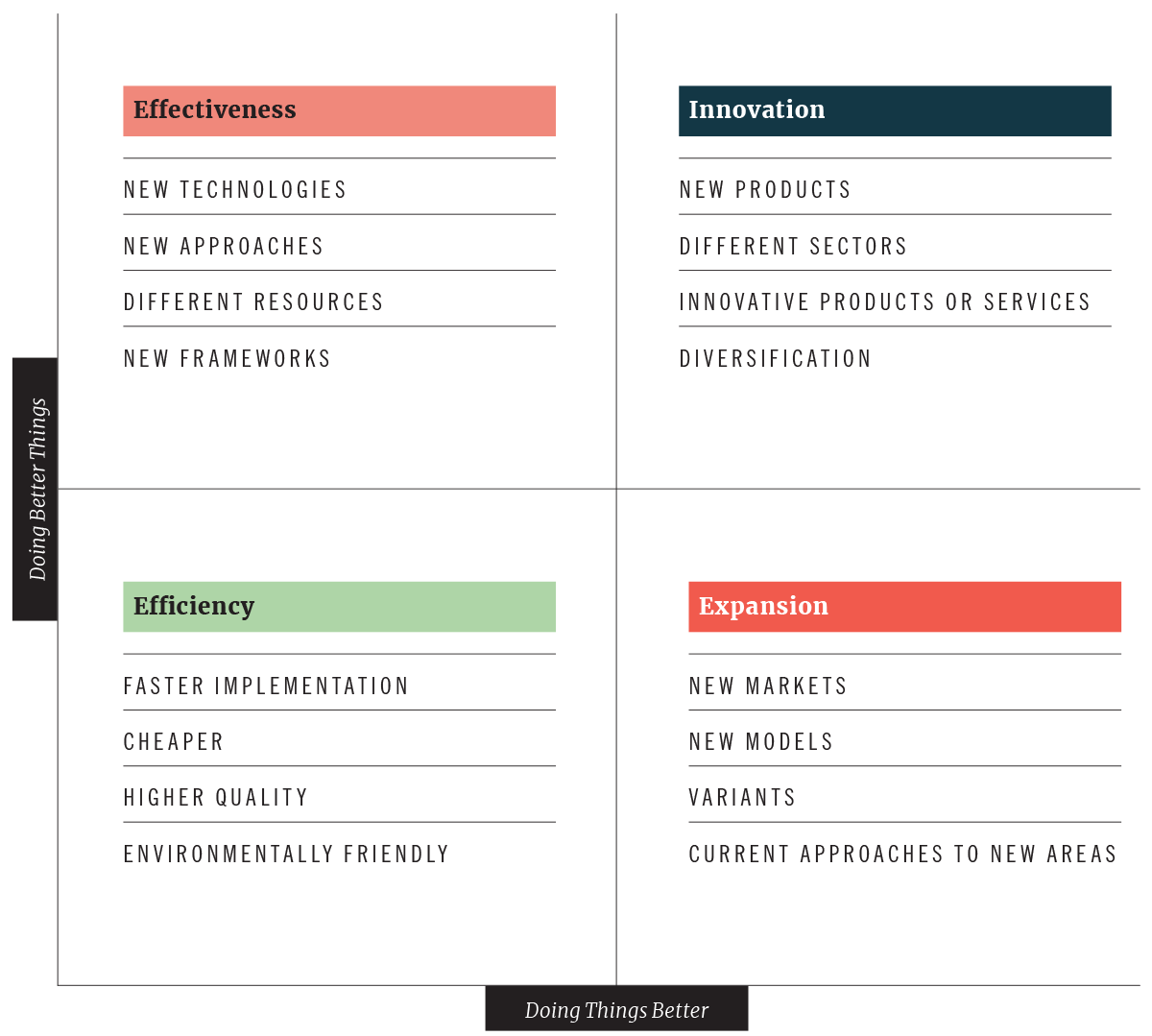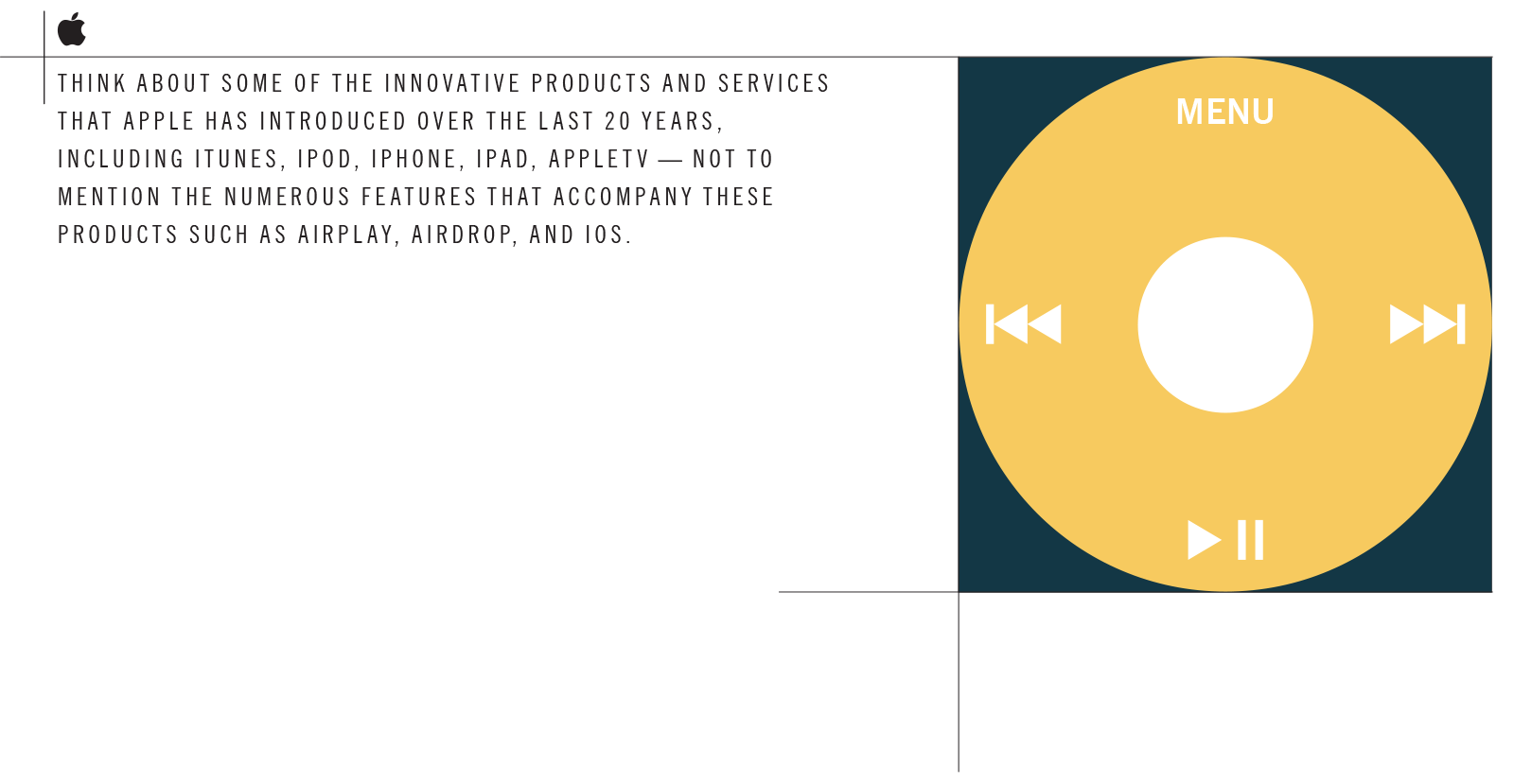
When it comes to improvement initiatives such as enhancing communication, improving delivery times, or reducing billing cycles, companies need to count past one. For years, executives have viewed improvement initiatives almost entirely through the lens of “getting better,” i.e., if we develop and launch this new product, our company will have a better product suite. In reality, “getting better” is only one of many goals companies should strive for when making improvements.
In short, there are four primary areas of improvement that executives should understand before they embark on a new initiative: Efficiency, Effectiveness, Expansion, and Innovation. Think of them as interconnected quadrants on an X-Y axis of “Doing Things Better” and “Doing Better Things” (see chart). Each quadrant contains examples of activities your company can engage in while undertaking an improvement initiative. For example, the Efficiency quadrant is about doing things better and faster in the space where we are operating today, while the Expansion quadrant is about applying existing (tried and true) approaches to new things. The hit rates for ideas in each of these quadrants vary, but together they can profoundly impact the success of your company in the long run.
And to ensure that your company is looking at all four from a holistic perspective, it’s critical to fully grasp each quadrant and how they interact. With that in mind, let’s take a closer look at each, as well as outline some practical applications management can apply in real time.
Bottom Left: Efficiency
Efficiency is the everyday tinkering; it’s operating in the space we are in today, but with a focus on improving speed, lowering cost, and/or reducing errors and improving quality. For example, when Toyota improves its product development process and cuts speed to market, they are focused on the efficiency quadrant. While no single improvement in this quadrant is likely to move the needle on a company’s overall performance, embarking on a number of efficiency-related changes can substantially impact the company’s bottom line. It’s worth also noting that efficiency is rarely where companies turn their attention when trying to improve — most get sucked into the top right quadrant of Innovation. However, it remains one of the most important levers, and executives would be wise not to lose focus on it. Walmart is a great example of a company that excels in the Efficiency quadrant.
Walmart is intensely focused on optimizing its supply chain, working hard to minimize the time it takes for supply to reach the shelf, guaranteeing that shipping vehicles are sufficiently filled with products, and ensuring that the right level of the right products is being manufactured. The result has been reduced costs and an improved in-store and online experience for its customers. While it may not seem exciting or flashy, Walmart has found a way to efficiently restock inventory, deliver products to its customers when they need it, and, in many instances, pass along efficiency savings to its customers — all of which has allowed it to be a low-price leader.
Top Left Quadrant: Effectiveness
Effectiveness is doing what we do now but in new ways. For example, applying automated call routing in place of an operator to manually transfer calls to the appropriate party. Effectiveness is the classic IT-driven improvement, applying new technologies and possibilities to our current practices and processes. Think computers and how they have offered speed and financial savings to companies.
Best Buy is a great example of a company that has focused on the Effectiveness quadrant. Even before the pandemic, Best Buy realized that consumer preferences were shifting away from in-store and toward online purchasing. As such, while its product offering has remained consistent, its focus has been on improving the online experience through technology investments and redesigned processes — i.e., offering recommendations for additional products based on customer buying history and minimizing the number of clicks required to check out online. These initiatives have helped Best Buy remain relevant and shift a large portion of its sales to its online channel.

Bottom Right Quadrant: Expansion
Expansion is essentially using existing approaches to do new things, and it includes a technique that has served engineers well for years: cross-fertilization. If an approach or technique works well in one part of your company, chances are it can offer benefits in other parts too. Cross-fertilization is enabled by collaborative cultures, and it is severely restricted by cultures that allow silo-building and defensive behavior. Rewarding employees for creative thinking and offering expansion ideas outside of their everyday jobs can help.
An example of a company that has excelled with an Expansion focus is Five Guys, the fast-casual burger chain that started in a few local markets in the Northeast but has grown to more than 1,500 stores across the United States and internationally. Today you can enjoy a Five Guys burger and fries on the Champs-Élysées in Paris! The successful expansion was accompanied by extreme attention to detail and deep market analysis. Through this growth, Five Guys has kept the same business model and principles but found creative ways to stretch to new markets.
Whereas Five Guys expanded into different markets with the same model, Facebook is a prime example of a company that has grown by adapting and evolving with its target audience. When Facebook first started, its primary users were under 21 years old. Throughout the years, it has evolved its newsfeeds, advertisements, and algorithms as its target market has aged into a different phase of life. Today 53 percent of Facebook users are over 35 years of age. Yes, part of this may have been driven by younger demographics organically moving to other platforms (e.g., Instagram or TikTok), but even so, Facebook remains a strong example of a company catering to its target demographic and changing as those demographics change.
Top Right Quadrant: Innovation
Innovation The top right quadrant, Innovation, involves doing “cool and clever” things that haven’t been done before. And while the hit rates on ideas in this category are the lowest amongst the four quadrants, a great innovative idea can transform a company’s fortunes.
To be successful with innovation, managers need to encourage outside-the-box thinking, even if more than 90 percent of ideas are likely to be non-starters. Sure, it can seem like an expensive waste of time and money, but the last 100 years have shown the massive difference that those viable extreme ideas bring. Think Kitty Hawk to the moon in 63 years. That never would have happened without visionaries who were willing to give “ridiculous” ideas a chance. Nor would we have done it without a seemingly endless stream of daft-sounding ideas that were, in fact, really daft but still worth an open mind. Tips for encouraging innovation include offering incentives, participating in design thinking workshops, and providing transparency into your company’s strategic objectives.
Apple comes to mind for companies that have excelled in the Innovation quadrant. Think about some of the innovative products and services that Apple has introduced over the last 20 years, including iTunes, iPod, iPhone, iPad, AppleTV — not to mention the numerous features that accompany these products such as AirPlay, AirDrop, and iOS. While there have been many successes, there have also been many failures (e.g., the Round Mouse, the U2 iPod, MacIntosh TV), but the successes have proved more memorable and sustaining, and they have reshaped an entire industry. Apple has consistently demonstrated an Innovation mindset over the years and has achieved extreme brand loyalty as a result.
Practical Applications of the Four Quadrants
It is important to understand that the four quadrants outlined above are not distinct. Don’t look at the lines that separate the types but view the chart instead as a range of ideas that merge into one another. Maintaining a focus across the range will allow your company to generate groundbreaking and disruptive innovations, while also maintaining steady increases in effectiveness and economy. But how should you apply this information to your company? Here are five actionable steps that you can implement today:
1. Review the list of current ideas in the pipeline and identify gaps
Contemplate improvements in each of the quadrants by reviewing the list of current ideas in the pipeline. For example, you may find that your current ideas are heavily weighted on ways to expand your business (e.g., offer x products in x additional countries), but very light on how to make the company more efficient. By identifying gaps across the quadrants, you will shed light on areas that need focus.
2. Don’t ignore any of the quadrants
As one might imagine, there are risks for not paying attention to all four quadrants. For example, a company primarily focused on innovation might not be as effective or efficient as it can be, which can have negative impacts on sustainable profitability.
Blockbuster is the perfect example of a company that ignored at least one of the four quadrants. A video rental franchise that thrived in the late 1990s and early 2000s, Blockbuster was so laser-focused on the operational machinery and mastering supply chain, Efficiency Quadrant, that they did not see where the market was heading — essentially ignoring the Innovation quadrant. As a result, innovators such as Netflix — which focused on the newly emerging streaming market — contributed to the eventual downfall and bankruptcy of Blockbuster.
3. Measure and categorize improvements across their life cycle
Getting that balance starts with measuring improvements across their life cycle, and categorizing improvements that you or your company:
- Think about
- Talk about
- Schedule
- Deliver
- Report on
4. Determine the desired level of focus on each quadrant
Should all companies focus on the four quadrants equally? Definitely not. The level of focus on each can vary based on the following:
- What competitors are doing/innovation in the industry
- Barriers to entry
- Internal and external factors
- Maturity of company
There are a few companies that do all four quadrants well (e.g., Disney, Toyota, and Amazon), and as a result, it’s no coincidence that they are extraordinarily successful companies.
5. Don’t invest in improvements in all quadrants at the same time
There are only so many hours in a day, and many of us are stretched thin. Rather than investing in all quadrants simultaneously, we recommend regularly revisiting ideas in each quadrant in the context of your overall strategy.
